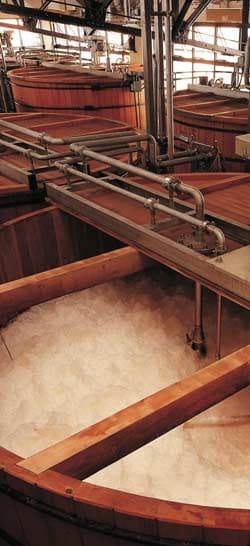YEASTS AND FERMENTATION

Although distillers never seem to place too much importance on this component, the yeast used during the fermentation process affects a whiskey’s aromatic palette. Yeasts are single-celled micro-organisms from the mushroom family that feed on sugar, producing alcohol and carbon dioxide in the process. The varieties of yeast used by distilleries are widely-known, but each distillery jealously protects the nature of the strains it uses, as well as their proportions and blends. This constitutes a top secret recipe.
YEAST FAMILY GROUPS
There are two broad categories of yeast: wild yeast and cultured yeast. Wild yeast is contained within the atmosphere and is still sometimes used to make craft beers, such as the Belgian beer Cantillon. This yeast is fragile and is only activated when the climatic conditions and natural microbial environment are just right, something over which humans have no control. Despite its great aromatic potential, distillers consider this yeast too risky to use and prefer cultured yeasts. Cultured yeasts, whether from breweries or distilleries, are the most frequently used - in a complementary fashion. They allow alcohol content to be predicted in advance, and the production of specific aromas that correspond to the aromatic profile of various types of whiskies.
FERMENTATION
A key component in the whiskey-making process, yeast activates the conversion of a simple sweet must into malt beer. At the end of the brewing process, a mix of water and malt known as the wort is cooled to around 20°C (the temperature required to activate the yeast). It is then moved to the washbacks, fermentation vats with sizes that vary from 1,000 litres to over 50,000 litres. Traditionally made from Oregon pine or larch wood, today these vats are very often replaced with stainless steel washbacks that are easier to maintain.
When the washback is two-thirds full, the yeast is added to the mix. Once the yeast is activated, the sugar contained in the wort is transformed into alcohol and carbonic gas. The resulting liquid is known as the wash. It begins to bubble, with its temperature rising from 20°C to 35°C. Rotating arms continuously stir the wash to ensure temperatures don’t rise too high, which would inhibit the yeast.
It takes between forty and sixty hours to convert all of the sugar into alcohol. The resulting liquid is a kind of malt beer with an alcohol content of between 6% and 8%. The wash is then poured into storage vats known as wash-chargers before being distilled.
THE IMPACT OF FERMENTATION ON AROMAS
Yeast not only converts sugar into alcohol - it also imparts some specific aromas. During the fermentation process, the esters responsible for many whiskies’ fruity, tart notes begin to appear. These esters provide characteristic notes of apricot, apple, pear and tropical fruit (banana, pineapple). Other aromas also emerge from the fermentation process. Whether floral (violet, box tree) or grainy (malt, porridge), after a number of years ageing, their presence serves as proof of the quality of the alcohol produced by a distillery.